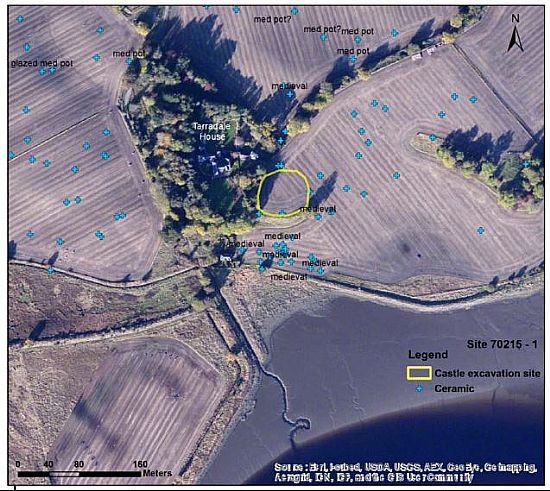Tarradale Castle
 Image copyright AOC Archaeology
Image copyright AOC Archaeology
2017 Data Structure Report.
The fact that there was a castle at Tarradale in the 13th and early 14th centuries is known from documentary sources. According the Wardlaw Manuscript, in continued efforts of pacification, Edward’s forces destroyed the forts of Inverness, Beufort and Dinguall in 1303; while Tarradale was also captured and given to Edward’s ally Alexander Comyn. The Tarradale site was later recaptured, supposedly destroyed, by Robert the Bruce in 1308.
The precise location of the castle has however proved more difficult to pin down. Field walking and metal detecting have discovered a concentration of medieval pottery that suggests that the motte of the castle may lie on a raised beach immediately southeast of Tarradale house, with a steep slope to the south serving as a defensive feature. Other finds have included large nails, a number of 13th century silver pennies and a horse harness pendant of the de Verdon family.


Tarradale Through Time believes that a bailey associated with the motte lies on the lower raised beach just below the steep abandoned shoreline. A 2015 magnetometer survey of the site by Oskar Sveinbjarnarson (University of Aberdeen) identified potential evidence for buried archaeology on this site, including a potential ditch or bank enclosing a central feature where the motte is believed to be.


On the strength of the magnetometer evidence, the TARRADALE THROUGH TIME project excavated the upper and lower levels in September to October 2017, and although initially there appeared to be clear evidence of stone filled ditches or causeways, evaluation suggested that the features were not man-made but rather varying deposits of sand, gravel and boulders whose apparently ditch-like pattern resulted from their being deposited in an ancient streambed. In the relatively small area that was excavated, there was no evidence of human occupation.

Similarly on the lower level, the putative bailey site, the apparent enclosing ditch shown on the magnetometer survey turned out to be very shallow although some medieval pottery was preserved in the bottom of the ditch. The lack of any positive evidence of castle -like structures from excavation (in contrast to the wealth of field walking finds in the same locations) is difficult to explain. The density of medieval pottery revealed through field walking at the putative castle site is many times greater than the density of medieval pottery anywhere else in the study area. One suggestion for the lack of excavation evidence is that the whole site may have been comprehensively destroyed after it was captured by Robert Bruce in 1308, and we know that the castle was never rebuilt. Further degradation of the site could be due to agricultural activity and also to the possible removal of soil to level the lawn of the adjacent Tarradale House. However, we are not writing off the site yet as we are convinced that the site of Tarradale Castle is still close to the inferred area and further magnetometer survey, test pitting and larger scale excavations may yet reveal buried structures.
 Illustration by Pat Haynes
Illustration by Pat Haynes

